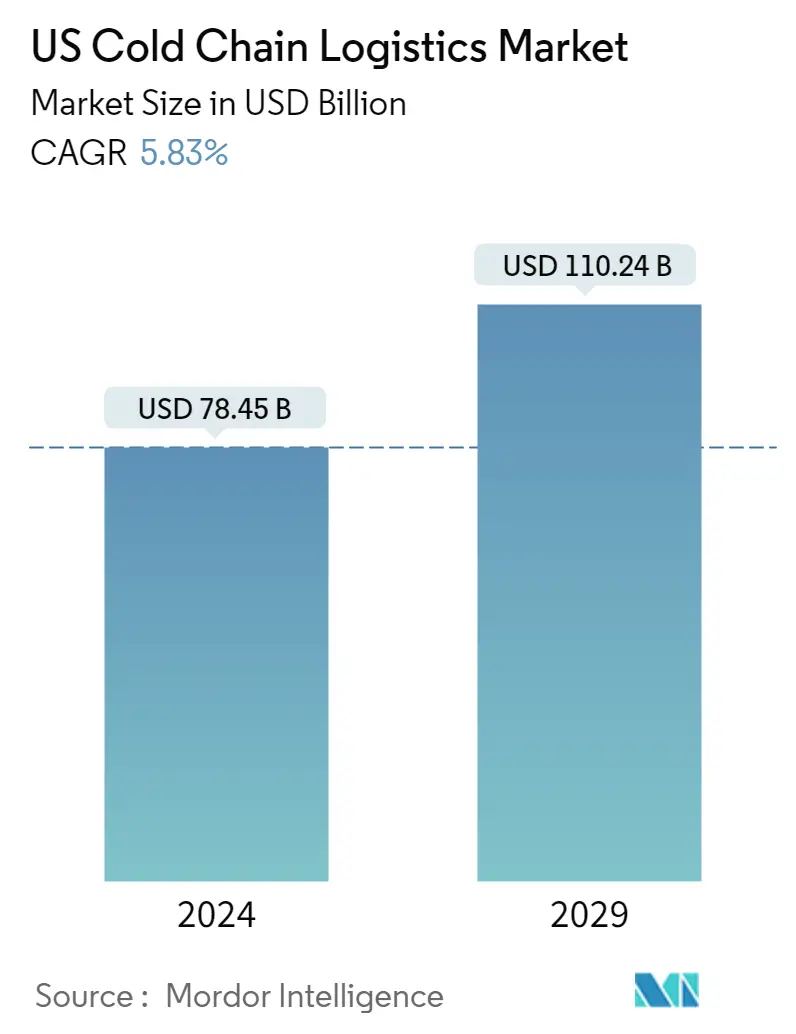Market Size of US Cold Chain Logistics Industry

| Study Period | 2019 - 2029 |
| Base Year For Estimation | 2023 |
| Market Size (2024) | USD 78.45 Billion |
| Market Size (2029) | USD 110.24 Billion |
| CAGR (2024 - 2029) | 5.83 % |
| Market Concentration | Low |
Major Players
*Disclaimer: Major Players sorted in no particular order |
US Cold Chain Logistics Market Analysis
The US Cold Chain Logistics Market size is estimated at USD 78.45 billion in 2024, and is expected to reach USD 110.24 billion by 2029, growing at a CAGR of 5.83% during the forecast period (2024-2029).
- The COVID-19 pandemic significantly boosted the domestic e-retailing sector and the consumption of processed foods and beverages, pushing the demand for refrigerated storage spaces and logistics. The rise of online groceries, with a significant share of orders for perishables and frozen foods, is also supporting the market demand. The market has also benefitted significantly from the stringent government regulation toward the production and supply of temperature-sensitive products.
- However, the labor shortages in the transportation and warehousing sector, high energy requirements, and the negative environmental impact of the cold chain logistics operations are some of the challenges that may limit the market growth. To tackle the challenges regarding the high energy requirements and negative environmental impact, some companies are introducing solutions that increase the energy required to run the cold chain infrastructure.
- Technologies like Artificial Intelligence (AI), Machine Learning, Internet of Things (IoT), Robotics, Ware, and distribution center automation are being incorporated by players to increase the efficiency of their operations, reduce operational costs, and provide better customer experience.
- More outsourcing is occurring throughout the broader industrial logistics market, with third-party logistics (3PL) providers accounting for 34% of total leasing activity in 2022 through May, up from 30% in the same period of 2021. This trend is particularly common in the cold storage industry due to costs and more complex technology systems.
- According to the US Department of Agriculture (USDA), 72% of the refrigerated storage capacity in the US is outsourced to public refrigerated warehouse (PRW) companies, down from 75% five years ago. The remaining 28% includes in-house cold chain operators, up from 25% five years ago.
- The perishables imports, pharmaceutical industry growth, including the biologics sector, increasing consumption of frozen foods, pharmaceutical temperature monitoring regulations, etc., are the demand drivers for the cold chain logistics market in the United States.
US Cold Chain Logistics Industry Segmentation
Cold chain logistics involves the careful management of temperature-sensitive products throughout their storage and transportation. It ensures the integrity and quality of goods like food, pharmaceuticals, and chemicals by maintaining specific temperature conditions, such as chilled or frozen, to prevent spoilage, degradation, or loss of efficacy.
The United States cold chain logistics market is segmented by service (storage, transportation, and value-added services), by temperature type (chilled and frozen), and by application (horticulture (fresh fruits & vegetables), meats, fish, and poultry, processed food products, pharma, life sciences, and chemicals, and other applications).
The report also covers the impact of COVID-19 on the market. The report offers market size and forecast for the United States cold chain logistics market in value (USD) for all the above segments.
| By Services | |
| Storage | |
| Transportation | |
| Value-added Services (Blast Freezing, Labeling, Inventory Management, etc.) |
| By Temperature Type | |
| Chilled | |
| Frozen | |
| Ambient |
| By Application | |
| Fruits and Vegetables | |
| Dairy Products (Milk, Butter, Cheese, Ice Cream, Etc.) | |
| Fish, Meat, and Seafood | |
| Processed Food | |
| Healthcare & Pharmaceuticals | |
| Bakery and Confectionary | |
| Other Applications |
US Cold Chain Logistics Market Size Summary
The US cold chain logistics market is experiencing significant growth, driven by the increasing demand for refrigerated storage and transportation solutions. This demand is largely fueled by the rise in e-retailing, particularly in the online grocery sector, which has seen a surge in orders for perishables and frozen foods. The market is also supported by stringent government regulations concerning temperature-sensitive products, which have further bolstered the need for efficient cold chain operations. However, challenges such as labor shortages, high energy requirements, and environmental concerns pose potential limitations to market expansion. To address these issues, companies are adopting advanced technologies like AI, IoT, and robotics to enhance operational efficiency and reduce costs.
The market's growth is further propelled by the increasing import of perishables, the expansion of the pharmaceutical industry, and the rising consumption of frozen foods. The United States imports a substantial portion of its fresh produce, with Mexico being a key trading partner. The cold chain logistics sector is also witnessing a trend towards outsourcing, with third-party logistics providers playing a significant role in managing refrigerated storage capacities. Despite challenges, the market remains robust, with major players like FedEx, XPO Logistics, and Americold Logistics actively expanding their operations and investing in new technologies to meet the growing demand for temperature-controlled logistics solutions.
US Cold Chain Logistics Market Size - Table of Contents
-
1. MARKET DYNAMICS AND INSIGHTS
-
1.1 Current Market Scenario
-
1.2 Market Dynamics
-
1.2.1 Drivers
-
1.2.1.1 PHARMACEUTICAL INDUSTRY GROWTH
-
1.2.1.2 RISING FRESH PRODUCE IMPORTS FROM MEXICO
-
1.2.1.3 INCREASING POPULARITY OF FROZEN FOODS
-
-
1.2.2 Restraints
-
1.2.2.1 EMISSIONS FROM COLD CHAIN OPERATIONS
-
1.2.2.2 LABOUR SHORTAGES
-
-
1.2.3 Opportunities
-
1.2.3.1 Adopting energy-efficient solutions
-
1.2.3.2 rise of online grocery business
-
-
-
1.3 Industry Attractiveness - Porter's Five Forces Analysis
-
1.3.1 Bargaining Power of Buyers/Consumers
-
1.3.2 Bargaining Power of Suppliers
-
1.3.3 Threat of New Entrants
-
1.3.4 Threat of Substitute Products
-
1.3.5 Intensity of Competitive Rivalry
-
-
1.4 Insights on Technological Trends and Automation
-
1.5 Insights on Government Regulations and Initiatives
-
1.6 Industry Value Chain/Supply Chain Analysis
-
1.7 Spotlight on Ambient/Temperature-controlled Storage
-
1.8 Impact of Emission Standards and Regulations on Cold Chain Industry
-
1.9 Impact of Covid-19 on the Market
-
-
2. MARKET SEGMENTATION
-
2.1 By Services
-
2.1.1 Storage
-
2.1.2 Transportation
-
2.1.3 Value-added Services (Blast Freezing, Labeling, Inventory Management, etc.)
-
-
2.2 By Temperature Type
-
2.2.1 Chilled
-
2.2.2 Frozen
-
2.2.3 Ambient
-
-
2.3 By Application
-
2.3.1 Fruits and Vegetables
-
2.3.2 Dairy Products (Milk, Butter, Cheese, Ice Cream, Etc.)
-
2.3.3 Fish, Meat, and Seafood
-
2.3.4 Processed Food
-
2.3.5 Healthcare & Pharmaceuticals
-
2.3.6 Bakery and Confectionary
-
2.3.7 Other Applications
-
-
US Cold Chain Logistics Market Size FAQs
How big is the US Cold Chain Logistics Market?
The US Cold Chain Logistics Market size is expected to reach USD 78.45 billion in 2024 and grow at a CAGR of 5.83% to reach USD 110.24 billion by 2029.
What is the current US Cold Chain Logistics Market size?
In 2024, the US Cold Chain Logistics Market size is expected to reach USD 78.45 billion.

